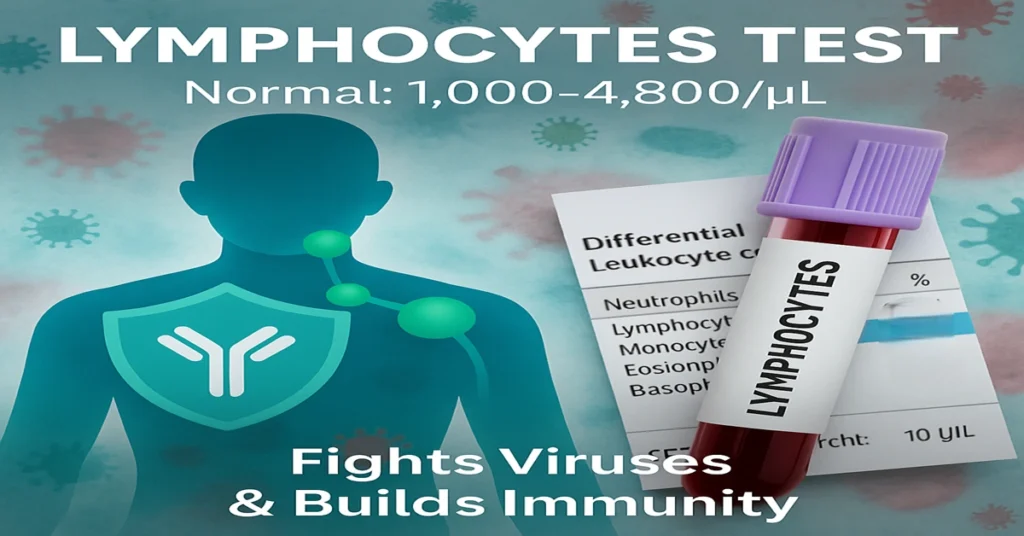What is the Lymphocytes Test?
The Lymphocytes Test measures the number or percentage of lymphocytes in your blood. Lymphocytes are a type of white blood cell (WBC) that play a key role in the immune system. They help fight viruses, produce antibodies, and remember past infections for long-term immunity.
This test is part of the Complete Blood Count with Differential (CBC with diff), which shows the types of white blood cells in detail.
Where Are Lymphocytes Synthesized/Produced in the Body?
Lymphocytes are produced in the bone marrow from stem cells.
- B lymphocytes (B cells): Mature in the bone marrow and produce antibodies.
- T lymphocytes (T cells): Mature in the thymus gland and kill infected or abnormal cells.
After formation, lymphocytes travel to the lymph nodes, spleen, tonsils, and bloodstream to protect the body.
Main Functions and Importance of Lymphocytes
- Fight Viral Infections: Defend against viruses like flu, hepatitis, HIV.
- Immune Memory: Remember past infections to respond faster.
- Produce Antibodies: B cells create antibodies to neutralize pathogens.
- Kill Infected or Cancerous Cells: T cells directly attack abnormal cells.
- Coordinate Immune Response: Control and guide other immune cells.
Lymphocytes are essential for long-term immunity and recovery from infections.
Causes of Low Lymphocyte Count (Lymphocytopenia)
- Viral infections: HIV, hepatitis, influenza
- Autoimmune diseases: lupus, rheumatoid arthritis
- Bone marrow disorders: aplastic anemia, leukemia
- Malnutrition (low protein, zinc, or B12)
- Chemotherapy or radiation therapy
- Corticosteroid use
- Severe stress or major illness
- Rare congenital immune disorders
Symptoms of Low Lymphocytes
- Repeated infections
- Slow recovery from illness
- Fatigue or weakness
- Swollen glands
- Fever of unknown cause
- Weak immune system response
Causes of High Lymphocyte Count (Lymphocytosis)
- Viral infections: mononucleosis (EBV), CMV, mumps, measles
- Tuberculosis (TB)
- Whooping cough (pertussis)
- Chronic Lymphocytic Leukemia (CLL)
- Hepatitis
- After spleen removal (post-splenectomy)
- Certain autoimmune disorders
Symptoms of High Lymphocytes
- Often no direct symptoms
- May show infection signs: fever, sore throat, swollen lymph nodes
- In leukemia: unexplained weight loss, night sweats, fatigue, frequent infections
Reference Ranges
(may vary slightly by lab)
Absolute Lymphocyte Count (ALC):
- Adults: 1,000 – 4,800 cells/µL
- Children: 3,000 – 9,500 cells/µL
Lymphocyte Percentage (in WBC differential):
- Adults: 20% – 40%
- Children: 30% – 70%
Low Lymphocytes: < 1,000/µL (adults)
High Lymphocytes: > 4,800/µL (adults)
Sample Type
- Sample: Whole blood
- Tube Used: Lavender-top (EDTA) tube
Test Preparation
- Usually no fasting required.
- Inform doctor about medicines like steroids, chemotherapy, or immunosuppressants.
- Stay hydrated before the test.
When to Consult a Doctor
- If you have frequent or unusual infections.
- If you feel weak, tired, or have swollen glands.
- If your CBC shows lymphocytes consistently high or low.
- If you have family history of leukemia, lymphoma, or immune disorders.
Key Terms Explained
- Lymphocytes: WBCs that fight viruses, make antibodies, and provide immune memory.
- B cells: Produce antibodies.
- T cells: Attack infected or abnormal cells.
- Lymphocytopenia: Low lymphocyte count.
- Lymphocytosis: High lymphocyte count.
- CBC with Differential: Test that breaks down all types of WBCs.
~END~

